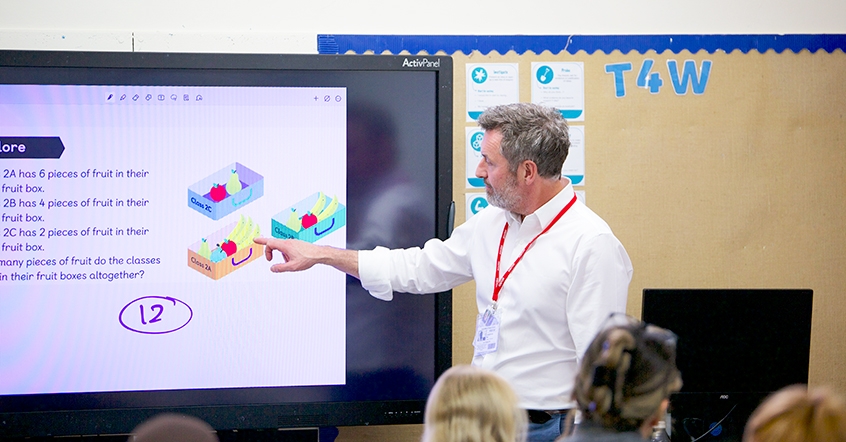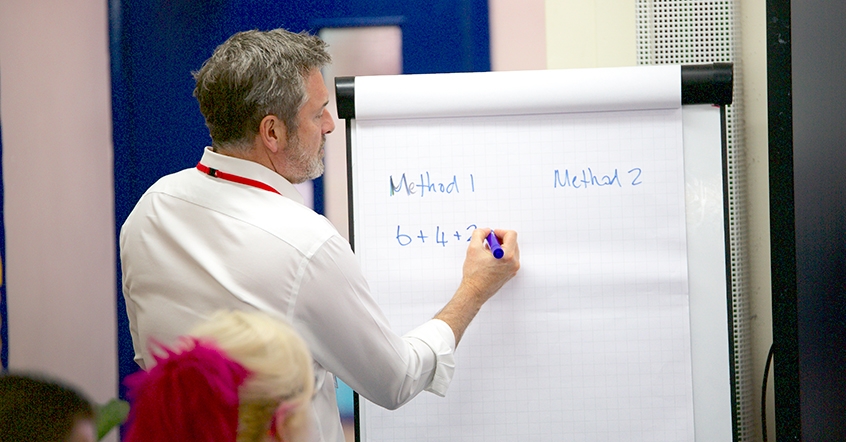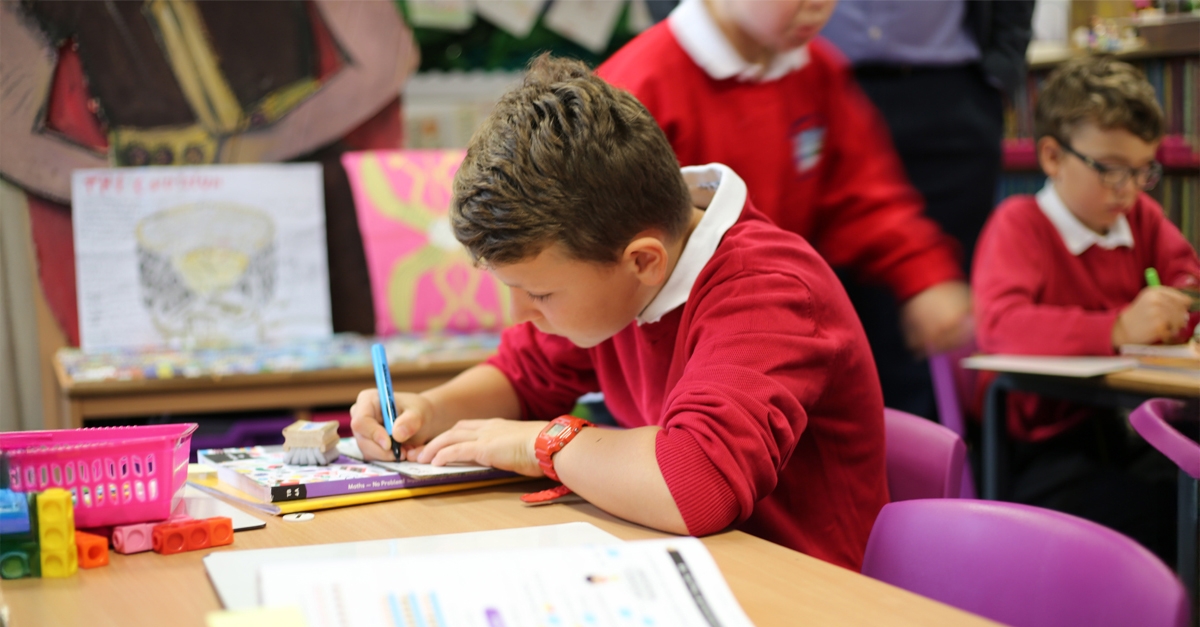Mateu Ramonet on fostering a ‘talk rich’ maths classroom
We've just noticed children thinking of themselves as mathematicians a lot more.
Mateu Ramonet says when he was a student, it felt like the goal in maths was simply to get through the material rather than to understand the concepts.
“It was very much a survival game; if you could show that you could keep up with what the teacher was telling you, that was seen as a good thing,” he said in a recent interview.
Now as Assistant Headteacher at Star Primary School in Newham, a borough in East London, Mateu’s goal is to shift the emphasis from getting through the content to understanding the content. “It's not about how quickly you get through something; it's about how well and how deeply it's understood.”
That resonates with the change he noticed most in the classroom when he started using Maths — No Problem! Now, the focus is on “what’s happening and what you’re doing,” which means talking the children through the process and spending a lot of time being able to see problems from many different angles.
Star Primary is a large, ethnically diverse inner city school, where almost a third of the approximately 600 pupils are eligible for pupil premium. Almost two thirds speak English as an additional language. It was rated “Good” in 2022 by Ofsted.

During the 2015-16 academic year, the school took part in a trial of Maths — No Problem! for Year 1 pupils, and, due to the “overwhelmingly positive feedback from pupils and staff” as well as the “very encouraging progress” the pupils made, the school decided to roll it out school-wide. They adopted the Maths — No Problem! Foundations Programme for Reception when it first came out in 2021-22.
Editor’s note: To learn more about Star Primary’s maths mastery journey, read their profile on our Accredited Schools page.
The school credits the adoption of Maths — No Problem! with a “vast increase” in teacher subject knowledge. Much of that progress comes from dedicating time to CPD, especially to developing the Concrete-Pictorial-Abstract approach.
“We're constantly thinking about those training needs all the time,” says Mateu. “No matter how many years I’ve been in the position, I'm always struck by how many different staff experiences come into it.”

The staff try to think about CPD not just from the staff perspective of what’s the best path, but also from the pupil perspective. That has led to a major shift in how the children think about maths and what they’re capable of. “We've just noticed children thinking of themselves as mathematicians a lot more,” Mateu says. “It's not a discipline that you're born with; it's something that can be molded.”
The view he tries to instill in everyone — teachers and staff alike — is that everyone should come to every single lesson with that confidence. The exploration element of the lessons and the fact that concrete materials are such a core part of the programme serve to foster that confidence.
Staff showcases
“Having those high aspirations for all pupils. That's something that you have to really believe in as a school. It can't be something that you just say on paper.”
That’s where staff showcases come in, because “more than anything, seeing is always believing.” He encourages staff to not be afraid to go and model lessons in other classes, and to discuss with colleagues afterwards. Showcases, he says, are a “really powerful tool to help that come to life.”
At Star Primary, teaching staff have the opportunity to observe lessons, ask questions, unpick the learning, and unpick why a lesson went a certain way. Staff showcases are internal versus open days, which are more external.

Mateu finds it fascinating the diversity of backgrounds and experiences that are represented when all of the schools and professionals who use Maths — No Problem! come together.
“I've spoken with colleagues from different parts of the country and with very different cohorts, very different mathematical experiences and different levels of support at home. There's so much that goes into it.”
But they all gravitate towards a common endpoint. “Mainly it's the core parts of the lesson and what that looks like at their school, those are the conversations that are really rich.”
He lists some of the commonalities:
- How would a school maximize the Explore part of the lesson?
- How much time would a school dedicate to the workbook task?
- What has worked, what hasn’t worked, and what have people tried?
“You can always learn that lesson the hard way yourself. But if other colleagues are telling you, ‘I've already spent three years down that road and we found that that doesn't work,’ that can always help.”
Contact with other schools usually happens through meetings at the local maths hub and the Maths — No Problem! Accredited School meet-ups. These are environments where rich conversations can thrive.
Transform Your Maths Assessment
Insights — our online assessment tool — gives you instant, powerful data to identify gaps and improve results.

Talk rich environment
Mateu is “super passionate” about fostering what he calls a “talk rich” environment at Star Primary. It’s about “children feeling the confidence to be able to talk about maths, and it not just being a discipline that is ‘either right or wrong, head down, getting your workbook.’”
Instead, he says lessons should be about conversations, whether they’re proving and disproving, or building up a strong case for why you want to look at something from a certain angle. “That to me is the kind of maths that we want to see here at Star.”
That means supporting the teachers with tools such as sentence stems, which promote the sort of rich discussion he’s after. He and his colleagues have also thought carefully about the skill of questioning over the years.
Staff are trained on how to ask specific questions that have open-ended results. That’s the opposite of going down a “funnelled path,” and instead, having the path be set by the children and their learning needs. He says it’s the teachers’ responsibility to capture that and guide that lesson where it needs to go.
What are some examples of open-ended questions?
At Star Primary, teachers use the Maths — No Problem! characters to begin framing that question. For example, the teacher might say, “Charles believes that…” and then give a certain theory. “What are your thoughts and can you prove or disprove this?”
Characters
As children grow up and move into different year groups, the Maths — No Problem! characters grow up with them. In this way, they have a familiar companion who will accompany them and guide them on their journey.
This companion even has a personality and a story which is comforting to learners. As the pupils, and thus the characters get older, problems become more challenging and complex in line with their development.
Editor’s note: To learn more about how Maths — No Problem! characters are designed to enhance understanding, read our blog Five things you didn’t know about Maths — No Problem! textbooks.
“It’s not having one possible outcome, not ‘is it right or wrong?’ We're not trying to lead them down that road. It's more about exploring.”
According to Mateu, the children respond very well to this approach. “The thing that I always have to try and highlight to the teachers is that even in the oldest children, they're still really motivated to think about our characters.”
Journalling
Journalling is another aspect of the programme that Mateu and his colleagues have had to think carefully about, how it works alongside the workbook and how to make sure it happens organically, that it’s not overly taxing on both the children and the staff.
They use a separate book for the children to journal in, and they’ve done a lot of training around the different types of journaling.
Editor’s note: To learn more on this topic, check out our blog Four reasons why your maths learners should be journalling.
Mateu says staff pay attention to what different types of journals are most suited for different parts of a chapter. “Some of the outcomes are amazing. Why shouldn't we be capturing the children's thought processes? Some of those techniques that maybe have only ever been seen, or only ever thought of as working in, say, an English lesson, they can work in maths as well.”
English versus maths
To carry the analogy of how maths and English lessons could be similar, he says if a student is doing an essay in English, or writing a story, then he or she might just start jotting notes down or doing an outline. “The main driver for us is capturing that, and supporting the children building up their metacognition.”
Teachers are encouraged to think out loud. “So when a teacher would model an explanation, thinking out loud really helps to support the children’s own thought process and to make sure they're really clear on how they want to answer something, which is again something you would typically see in an English lesson, where maybe they're presenting an argument or they're learning how to write a report and the teacher would be encouraged again to think out loud to say, ‘I'm going to use an adjective here or this is where the noun might go.”
He wants to see the same thing come through in math. “We need to be promoting the children’s thoughts going down on the page. It is such a shame to lose that. So, it's something that we do here and we're constantly thinking about how to make it better.”
Learn more
The impact of CPD on education and pupil success
